Harvesting potatoes is easily one of the most fun garden tasks! Big, bushy green plants on top of the soil hide incredible riches beneath. But the exact thing that makes harvesting so fun—the glorious surprise of your bounty—also makes it a little tricky to know exactly when to dig up those delicious tubers.
We’re going to give you some easy-to-spot signs to know when is the perfect time to grab your potato fork and get to digging.
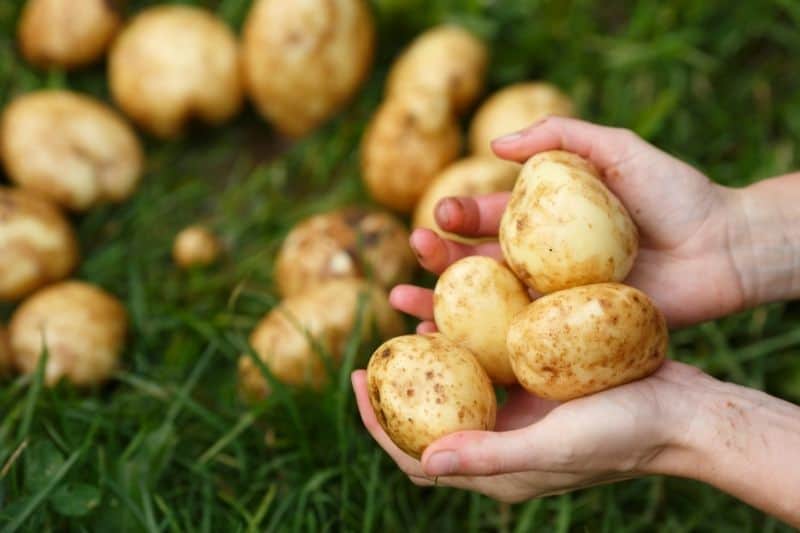
Table of Contents
How do you know when it’s time to harvest potatoes?
The great thing about potatoes is that once the tubers have started to set, you are welcome to dig them up anytime to grab potatoes. Depending on the size of potatoes you are after, here are two landmarks to look for:
- For new (baby) potatoes: Once the majority of your potato plants have started to flower, that’s a great time to start harvest new or baby potatoes. These creamy, tender early potatoes are a springtime treat that isn’t to be missed.
- For full-size potatoes: It’s easy to know when main crop potatoes are ready because all the leaves on your potato plants will be yellow or brown, and the plants will start to fall over. This means the plant has put all of its energy into the tubers, and it’s time to dig! If you see spots or other disease symptoms on the foliage or if die-off is only on some of your plants—this might not be the natural end of the plant’s life-cycle, and you should check for potato diseases.
Growfully Protip
Once you have dug your potatoes, it is very difficult to replant the potato plant and get it to produce more potatoes—so just keep that in mind when you go to dig new potatoes! You can gently poke around the base of the plant to see the size of potatoes before digging with good results.

Do potatoes have to flower before harvesting?
Flowering plants are a good sign that the plants have started to set tubers. If you harvest before flowering, you might have very small potatoes or no potatoes at all!
We recommend waiting to start harvesting until the majority of your potato plants are in full bloom—some folks even wait until the blooms have begun to fade and petals have started to drop.
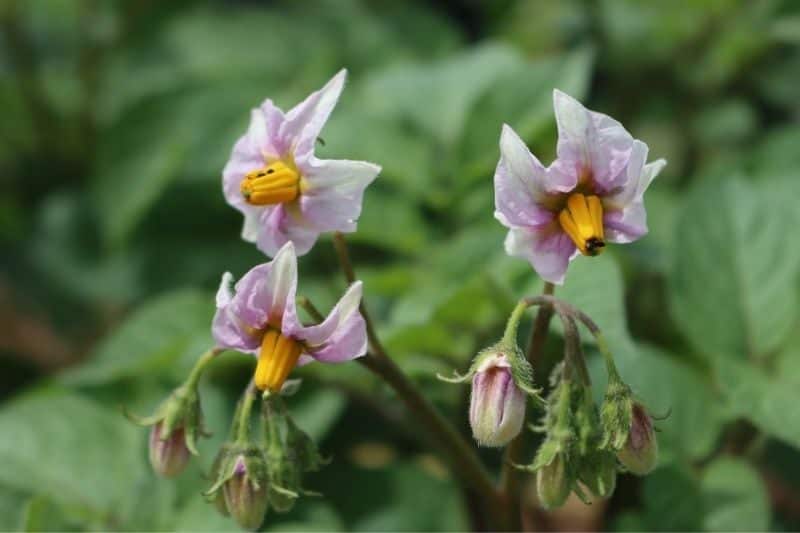
Can you harvest potatoes too early?
You can eat potatoes at any stage, but if you choose to harvest before the plants flower, your potatoes will be small (or you might not have any to harvest at all).
How many potatoes do you get per plant?
The yield of a potato plant will vary based on the specific cultivar, but in general, you can assume you’ll get 5-6 larger potatoes per plant, plus a handful of smaller-sized baby potatoes.
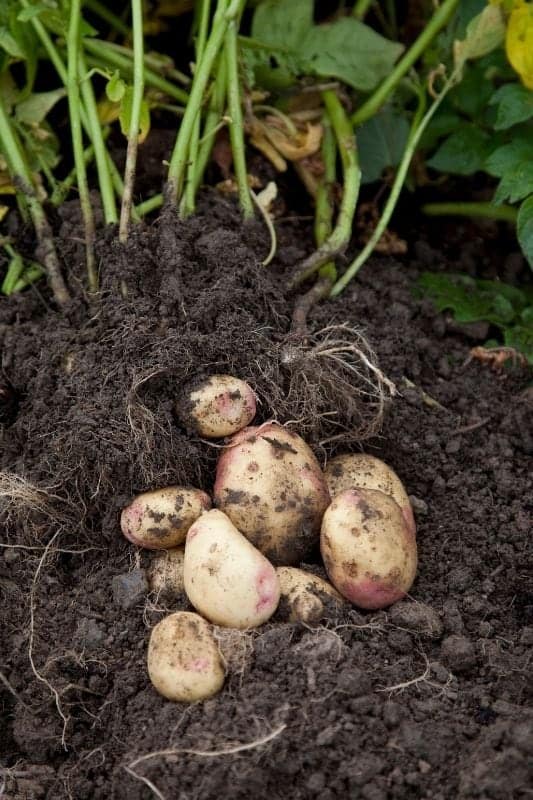
Why are my potato plants falling over?
While weak plants can be caused by potato disease or a heavy pest infestation, if your plants are falling over, most of the time it means the plant’s life cycle is finishing up and it’s time to harvest! Mature potato plants will have yellow or brown leaves, shriveling stems, and will no longer support themselves.
Growfully Protip
Here in Zone 6B, potato plants typically reach maturity in late June or early July for March-planted potatoes.
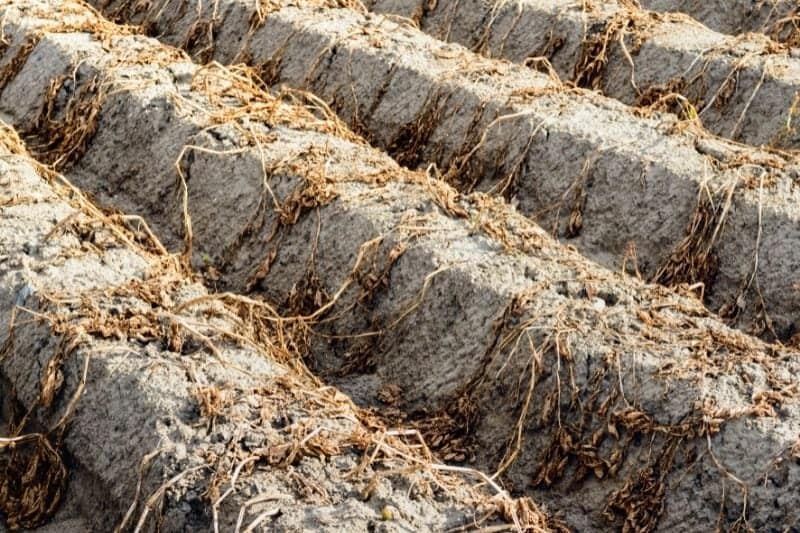
When should I stop watering my potato plants?
Stop watering your potato plants about 2-3 weeks before harvest, or when you first see the foliage on the plants starting to turn yellow. Make sure to harvest your potatoes on a dry day when the soil is dry—harvesting potatoes when wet or damp can cause the potatoes to rot more easily in storage.
What happens if you don’t harvest potatoes?
You’ll create a perennial potato patch! Depending on your climate, the potatoes left in the ground will either sprout soon and grow new plants or will overwinter and sprout new plants next spring.
Growfully Protip
It’s almost impossible to get every little potato out of a patch each year, so don’t be surprised if you see a few volunteer potato plants growing where you grew potatoes the previous year!
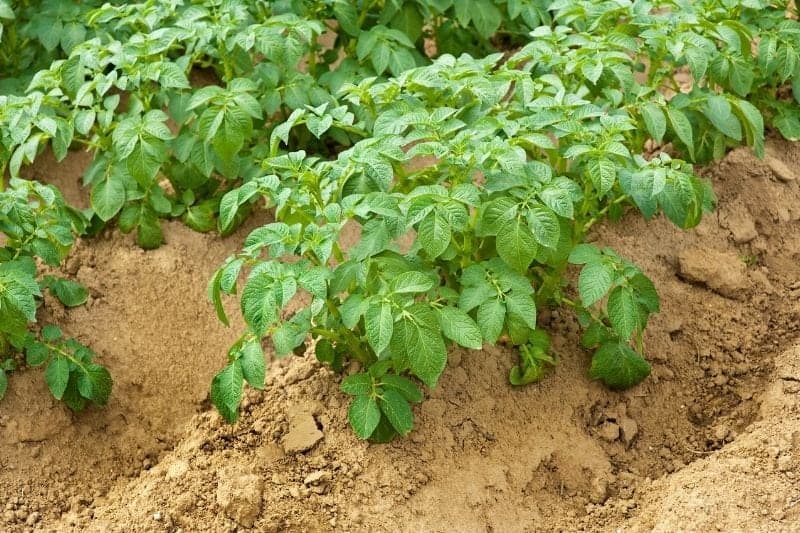
How long can potatoes stay in the ground?
In moderate or cold climates, potatoes can stay in the ground until the soil freezes in late fall or early winter. Some folks have success heavily mulching (with mulch like straw, wood chips, or shredded leaves) the patch to keep the soil from freezing and dig potatoes all winter long.
We recommend most folks head out with their potato fork and dig the patch up before the first hard freeze of the season.
In warmer climates, potatoes stored in the soil run the risk of sprouting new plants. Consistent soil temperature above 45°F will sprout potatoes.

Do potatoes keep growing after the plant dies?
Once the plant dies, the potatoes are finished growing in size. However, the skin on the potato does harden and cure to make it stronger for storage. We recommend leaving the potatoes in the ground for about 2 weeks after the plants have died off.
Can you eat potatoes right after harvest?
Sure can! While we recommend curing them for long-term storage, freshly-dug potatoes are perfect for eating right out of the ground (maybe clean them off a bit first).
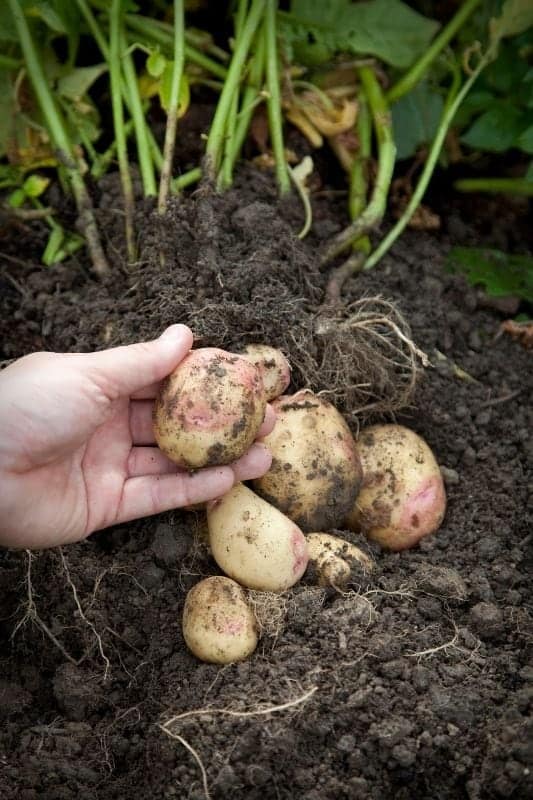
Why are my homegrown potatoes so small?
First of all, it’s important to know what varieties you are growing. Some potato varieties are meant to be small! Not all potato cultivars grown in the home garden will produce chunky russet baking potatoes. But if your potato is supposed to be big and isn’t, here are some reasons why:
- Improper growing conditions: Anything that stresses the plant out can cause reduced tuber size—lack of sunlight, over or under watering, nutrient deficiency, too high of temps.
- Pest or disease pressure: An unhealthy plant won’t set good-sized potatoes, so if a plant is stressed from pests or diseases, you’ll probably get smaller potatoes.
- Harvesting too early: As we covered before, the earlier you harvest, the smaller your potatoes will be. For the biggest potatoes, wait until the plant had died back.
Should you wash freshly dug potatoes?
If you are planning on using your potatoes immediately, yes, go ahead and give them a good rinse and a scrub before cooking with them.
If you want to store your potatoes (short term or long term), make sure to dig on a dry day, and then gently brush off any large clumps of soil, but don’t wash or scrub them until right before cooking. Moisture can spread disease and rot among storage potatoes.
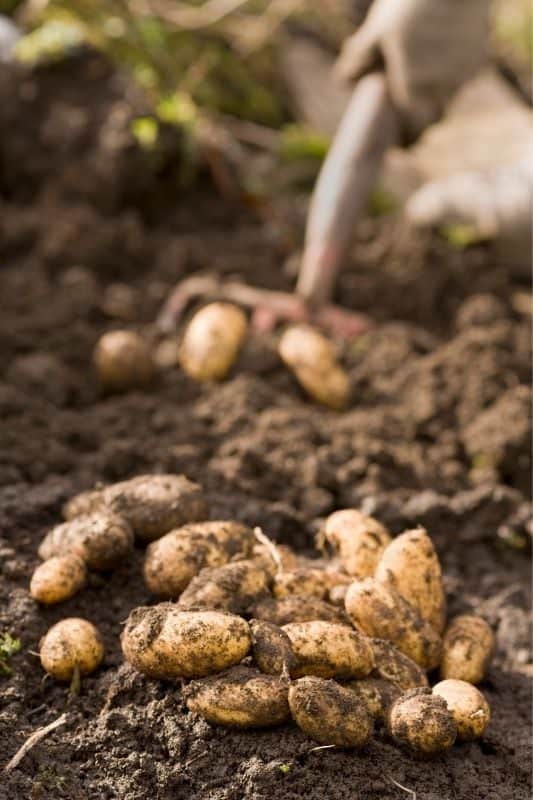
How do you keep potatoes after digging them up?
Cure your potatoes by placing them in a single layer on newspaper, trays, or carboard in a cool (50-60°F) and dark spot with relatively high humidity for 1-2 weeks. You can also cure potatoes in the soil by clipping off the dead plants at the soil level, and leaving the plants in the soil for 1-2 weeks before digging.
Before storing, remove and use immediately any potatoes that show signs of damage.
Once the potatoes are cured and picked through, store potatoes in baskets, crates, cardboard boxes (with holes poked in the sides), or brown paper bags. Don’t pile your potatoes too deeply—this can encourage rot to spread.

How do you store potatoes long term?
Make sure containers are covered or stored in a dark area to prevent light. Any light exposure during storage can cause the potatoes to sprout. Store the potatoes in a cool area (but above freezing) with high humidity.
An unheated basement, garage, or root cellar usually takes care of the cool part, and if you need to replicate the high humidity, you can cover the potatoes with a damp cloth and mist with a spray bottle when it dries out.








The time to harvest potatoes depends on the maturation period of the potatoes you’re growing. There are three varieties you should know about: first earlies, second earlies, and maincrop. There are two main signs you can start harvesting potatoes: dying foliage and blooming flowers.
Great article! Thanks for the great explanation of when potatoes are ready to harvest.
Thank you for the information on parties. I’m growing my potatoes in grow bags and an old wooden bushel basket. Some plants have turned yellow in the grow bag, but not all. After reading this I know now to wait to harvest.
I am in fort worth,TX and planted kennebec seed potatoes in march.it is now early june. The plants are turning a little yellow at bottom but tops are still very green and sturdy.we had torrential rain few days ago and now temps are getting in high 90’s.I dug one up out of curiosity and there was only one medium potato and four teeny ones..Do I still keep watering the plants till they’re totally yellow or dig them up now because of the heat?Are the potatoes getting bigger right now or not because of the heat? Thanks.
keep watering the potatoes until just a few days until you are ready to harvest. The potatoes will keep growing in size until the plant has died back.
Any advice? Prepping the garden for the new season and found a bunch of potatoes from last year’s crop. Can I eat them? They have some shoots growing out of them but look great. They just got missed in last years harvest and we underground over a cold winter in Vancouver bc. Would love to eat them but unsure if okay to do so.
They should be fine to eat as long as they weren’t exposed to the sun.
When the foliage from the potatoes is removed is it good practice to mulch the material and dig it in to the garden soil.hyour article is very comprehensive and indeed helpful.
I tend to just put the foliage in a separate compost bin, because I like to turn over my beds quickly in the middle of summer—but if you have time to let it decompose in the bed, I don’t see why it wouldn’t work.
Very informative about potatoes thank you Cassie.
How can I prevent snails and slugs in my tropical vegetable patch?
Check out our guide to controlling slugs in the garden: https://growfully.com/how-to-get-rid-of-slugs/ Hopefully some of these methods will work for your garden!
I have produced a cross between a potato and a tomato . Truss of Tomatoes on the potato foliage. More information and photos contact me.
Hi Roger, I don’t think crossing a potato and tomato is biologically possible. I think maybe what you’re seeing is the potato “fruit,” which a potato plant produces to generate seeds and looks an awful lot like a tomato. They are toxic, so please don’t eat them unless you are 100% sure they are tomatoes from a tomato plant!